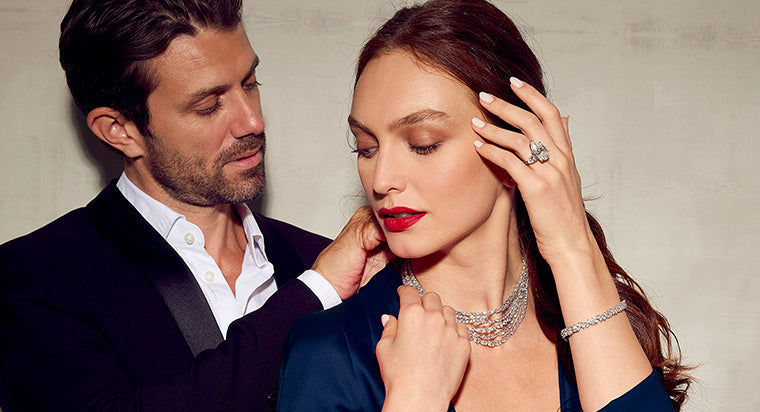10kt Gold Guide

It's no secret that you are often spoiled for choice when browsing jewelry. When it comes to choosing a piece, there are a lot of designs, materials, and styles to choose from! Not only do you have your pick of gems but the metal as well. One of the most popular options throughout the ages is gold.
Gold is classic for a good reason; this durable metal is resistant to corrosion and rust. It won't tarnish with wear and can look brilliant for decades, making it a common choice for engagement and wedding rings. When heated, it's relatively malleable, lending itself to various designs and styles.
While browsing gold jewelry, you may notice a marking stamped on the piece, called a hallmark. The hallmark refers to the purity of the gold, measured in karats. The purest gold is 24k gold, but it is much too soft for jewelry. Therefore, gold is alloyed (or mixed) with other metals, and the resulting karat shows the ratio of gold to non-gold metals.
What is 10kt Gold?
For those on a budget, 10kt gold jewelry is a great choice. To achieve 10kt gold, ten parts of pure gold are mixed with 14 parts other metals that usually include silver, palladium, zinc, nickel, or copper. To be exact, the ratio is 41.7% pure gold and 58.3% metal alloy. These metals can make the gold jewelry stronger and more resistant to bending and scratching while retaining its beautiful color.
10kt gold is the lowest ratio of gold to alloy allowed to be marketed as "gold" in the United States. Other gold purity levels include 14kt gold, which has a purity percentage of 58.3, and 18k gold, with 75 percent pure gold. Because less than half the piece of 10kt gold jewelry is composed of pure gold, 10kt isn't a popular choice for fine jewelry items. Usually, it is used to make 10kt gold bracelets or 10kt gold earrings.
You can find 10kt gold jewelry in the same color options as finer gold jewelry items, yellow gold, white gold, and rose gold. The alloy blend is what changes the color of the jewelry.
Each color offers a different look and a slight variation in characteristics. Therefore, choosing the color is best based on your taste and preference. You may also want to consider the following factors.
Advantages of 10kt Gold
10kt White gold is a popular choice for use in various jewelry pieces. It is a more modern choice with a cool and crisp appearance. The neutral tone of white gold goes very well with a plethora of stones and gems in everything from a 10kt white gold ring to a 10kt gold pendant. It can be more affordable than platinum and an excellent way for budget-conscious couples to get the look of platinum without the price.
Zinc, palladium, and silver are added to the pure gold to achieve white gold. These strong metals make the jewelry incredibly strong; resistant to warping and scratching.
10kt Yellow Gold
Yellow gold is a timeless option. It has long been used for wedding bands and all manner of jewelry. Yellow gold is made by mixing silver and copper with pure gold. The silver increases the strength of the jewelry while only slightly lightening the color.
Yellow gold is malleable, making it an excellent choice for achieving different designs. The warm hues can help disguise unfavorable tones in diamonds, such as yellow.
10kt Rose Gold
Rose gold has only recently seen a rise in popularity. Silver and copper mixed with pure gold give it its iconic pinkish color. This ring's high levels of copper make it more affordable than even 10kt yellow and white gold options.
The copper concentration also makes it less prone to scratch, warp, or bend. Its romantic color goes well with many stones and skin tones.
Disadvantages of 10kt Gold
Remember, 10kt gold is made by mixing pure gold with other metals. Due to this, there can be some disadvantages.
10kt white gold has a rhodium coating to increase durability and decrease corrosion. Unfortunately, this coating doesn't last forever and usually requires re-plating every few years to keep its color and shine. You'll notice brown, grey, or even yellow tones when the plating wears down.
10kt rose, and yellow gold can have disadvantages too. Because of the low pure gold content, 10kt gold jewelry can look a little duller than 14kt or 18kt gold. In general, it won't be as rich, lacking the luster and vividness of higher purity jewelry.
With every color of 10kt gold, you risk triggering allergies or skin sensitivities. Other metals, like nickel, are present in the jewelry. These alloys can lead to itchiness and irritation in some individuals.
Though 10kt gold is prevalent in everyday jewelry like 10kt gold hoop earrings and 10kt gold chains, it isn't often used for finer items such as engagement rings. Therefore, you may have difficulty finding a 10kt gold engagement ring or wedding band in your desired style.
How Can I Tell if My Gold is Fake?
The best way to know if your gold is fake is to check for a Certificate of Authenticity or COA. This seal or sticker guarantees that your gold jewelry is authentic. It comes from the maker, designer, or manufacturer and is an official document verifying your gold is real. You'll want to keep this documentation as long as you have your jewelry.
However, you can also test your gold at home. The first way to check if your gold is fake is by using the magnet test. Gold is not magnetic and therefore shouldn't move the magnet. The alloy metals, like silver, are usually non-magnetic as well. If the jewelry moves the magnet, it likely isn't real gold.
The second test is the float test. Gold is a dense metal that will sink in water. A floating gold piece of jewelry may not be real gold at all. But remember, the best way to verify your gold is with a letter or certificate of authenticity.
What to Keep In Mind When Buying Gold Jewelry
Whether you're looking for an 18kt or 10kt gold ring, there are a few factors to keep in mind.
Look for the certificate of authenticity. You want to know that your gold is real gold and not fake, especially if you're purchasing a significant item like an engagement ring.
When purchasing online, choose a reputable brand with excellent reviews. Don't forget to check their return policy and note any restocking fees.
If you're searching for 10kt gold jewelry, you may want to consider buying hallmark gold jewelry. These items will have the purity level of the gold stamped on them. You should see a "10K" on ten karat gold jewelry. As gold jewelry above nine karats should always be legally hallmarked, this stamp can help verify its authenticity.
Care and Maintenance for 10kt Gold Jewelry
Like most gold, 10kt gold jewelry typically doesn't require aggressive cleaning. The following tips can help:
• Use warm water with mild dish soap and a soft brush to gently clean your jewelry.
• Abrasives and detergents, such as toothpaste or baking soda, should be avoided.
• You can buff your jewelry with a dry, soft, lint-free cloth.
• Polishing cloths can be sourced from a reputable jeweler.
• Every few years, your 10kt white gold may require re-plating. You can visit a jeweler to have your jewelry professional cleaned or re-plated as needed.
FAQs
Is 10kt gold worth buying?
10kt gold jewelry is an affordable choice for budget-conscious couples. It can offer the beautiful look of gold while being more durable and resistant to scratching.
Can you wear 10kt gold every day?
10kt gold is a popular choice for everyday jewelry because of its strength and durability. You can wear it daily as long as your skin is not sensitive to the other alloy metals.
Does 10kt gold tarnish?
Due to the other metals combined with pure gold, 10kt gold is susceptible to tarnishing. This natural occurrence can cause a patina that is desirable to some individuals.
What is better 10kt gold or 14kt gold?
If you are conscious of purity, 14kt gold is purer than 10kt gold. However, 10kt gold is slightly more strong and often more affordable.









